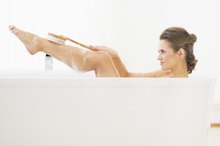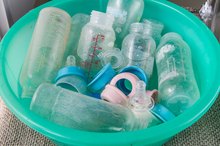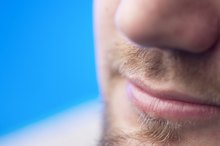How to Remove Chlorine From the Hair & Body
Chlorine acts as a disinfectant in swimming pool water, killing the bacteria responsible for a host of diseases. According to the American Chemistry Council, the chlorine in pool water requires daily testing to ensure that the water-to-chemical ratio is in check 1. Despite its benefits, chlorine can be very drying to the hair and skin, so you should shower to remove the chlorine from your hair and body after swimming.
Remove your swimsuit immediately after you have finished swimming and step into the shower. Mix 1/2 cup of distilled white vinegar and 1/2 cup of water in a disposable cup. Put the cup in the shower for later use as a hair rinse.
How to Remove Black Dots from Leg Hair Follicles
Learn More
Rinse your hair and body with warm water in the shower. Pour a quarter-sized amount of protein-based shampoo into the palm of your hand.
Massage the shampoo into your hair and scalp. Rinse the shampoo from your hair with water from the shower.
How to Use Sulfur Powder for Hair
Learn More
Pour the vinegar and water in the disposable cup onto your hair ends. Allow the vinegar to sit on your ends for five minutes. Rinse the vinegar and water solution from your hair after the five-minute waiting period.
Lather up your skin with your favorite soap or liquid body wash to remove the chlorine from your skin. Rinse the soap and chlorine residue away with water from the shower.
Tips
Apply a leave-in conditioner to your hair after washing if you find that your hair is dry after swimming. You may also want to apply a deep conditioner to your hair once a week to add moisture.
Warnings
Wear a swimming cap if you have light colored hair and swim in a chlorinated pool regularly. Blonde hair that lacks protection from chlorine can turn green. If this happens, you will need to use a chlorine removal shampoo to remove the green.
Related Articles
References
- American Chemistry Council: Pool Treatment 101: Introduction to Chlorine Sanitizing
- Health Services at Columbia: Chlorine Effects on Hair
- Novak-Bilić G, Vučić M, Japundžić I, Meštrović-Štefekov J, Stanić-Duktaj S, Lugović-Mihić L. Irritant and allergic contact dermatitis - skin lesion characteristics. Acta Clin Croat. 2018;57(4):713–720.
- Centers for Disease Control and Prevention. Rashes. Reviewed May 4, 2016.
- Centers for Disease Control and Prevention. Parasites - Cercarial Dermatitis (also known as Swimmer's Itch). Reviewed October 22, 2018.
- Rossetto AL, Da Silveira FL, Morandini AC, Haddad V, Resgalla C. Seabather's eruption: report of fourteen cases. An Acad Bras Cienc. 2015;87(1):431-6. doi:10.1590/0001-3765201520130468
- Chaumont A, Voisin C, Sardella A, Bernard A. "Interactions Between Domestic Water Hardness, Infant Swimming and Atopy in the Development of Childhood Eczema." Environmental Research. 2012 Jul;116:52-7. DOI: 10.1016/j.envres.2012.04.013.
- Gomà A, de Lluis R, Roca-Ferrer J, Lafuente J, Picado C. "Respiratory, Ocular and Skin Health in Recreational and Competitive Swimmers: Beneficial Effect of a New Method to Reduce Chlorine Oxidant Dervatives." Environmental Research. 2017 Jan;152:315-321. DOI: 10.1016/j.envres.2016.10.030.
- Khodaee M, Edelman GT, Spittler J, et. al. "Medical Care for Swimmers." Sports Medicine Open. 2016 Dec; 2: 27. DOI: 10.1186/s40798-016-0051-2.
- Salvaggio HL, Scheman AJ, Chamlin SL. "Shock Treatment: Swimming Pool Contact Dermatitis." Pediatric Dermatology. 2013 Jul-Aug;30(4):494-5. DOI: 10.1111/pde.12017.
Writer Bio
Jonae Fredericks started writing in 2007. She also has a background as a licensed cosmetologist and certified skin-care specialist. Jonae Fredericks is a certified paraeducator, presently working in the public education system.









